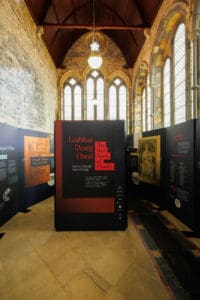A new exhibition unveiled at St Canice’s Cathedral
For the first time in history, a 14th-century manuscript known as The Red Book of Ossory has gone on public display.
A remarkable manuscript, The Red Book, had been returned to St Canice’s Cathedral in Co. Kilkenny, where it was written 700 years ago by ‘the most extraordinary bishop’, Bishop Ledrede.
The 79-page vellum manuscript is the centrepiece of a new year-long exhibition. The Red Book, named for its dyed red leather cover, has survived wars, plagues, and centuries. The exhibition will take visitors on a journey through time and page, offering a glimpse into the life of ordinary citizens through the lens of Bishop Ledrede, who held the See of Ossory from 1317 to 1360.

The Red Book of Ossory exhibition is now open, some 700 years after it was written in the cathedral. “Its return to the cathedral brings the city’s history to life, connecting us to a person and a time in a new and profound way,” said the organiser, The Very Reverend Stephen Farrell, Dean of Ossory.
First recorded recipe for Aqua Vitae
Among the pages of The Red Book is the first recorded recipe for Aqua Vitae, Uisce Batha, known today as whiskey. The recipe was medicinal in the 1300s as the plague ravaged Europe.

Dean Farrell explains, “Richard Ledrede came here to reinvigorate his See, to stabilise the community. He kept everything he thought was important in The Red Book—just after the Black Death, when illness had ravaged the city, he put in there the height of modern science, a three-page shorthand Latin recipe for Aqua Vitae.
He was a man of faith and science, trying to look after the people in his care. It would be like someone having a recipe for the COVID vaccine today.”
Living history and enduring legacy of Bishop Ledrede
Visitors will discover how democracy, rights, and culture were shaped in Medieval Ireland. Ledrede banned clergy from playing football on the cathedral grounds. He also decreed they should put away their concubines, and ‘none below the rank of a bishop is to absolve from murder’.”
In 1324, he famously accused noblewoman Alice Kyteler of witchcraft and heresy, leading to the first witch trials in Ireland.
The manuscript also features early provisions of the Magna Carta, poems and songs composed by Bishop Ledrede and a letter from King Edward III expressing concern that the noble Englishmen had ‘gone native’.
Written in Latin, Old English, and French, the ornate calligraphy was intended for well-educated church members. Today, it is displayed at St. Canice’s Cathedral and Round Tower.
Journey through time and page
The exhibition will take visitors on a journey through the pages of The Red Book and explore life in Ireland in the 14th century.
Visitors will get a unique insight into Medieval Ireland, the events leading to the witch trials, democracy and rights, poems and songs of the time, aqua vitae – the water of life, The Magna Carta, King Edward’s letter and more. St Canice’s Cathedral and Round Tower has a programme of talks, events and workshops to accompany the exhibit throughout the year-long exhibition.
The first ‘turn’ will be on the recipe for aqua vitae. Every 12 weeks, a new vellum will be revealed to show new passages to the public and protect the pages and spine of the ancient manuscript.

Dean Farrell commented, “It’s glorious to have Bishop Ledredes Red Book back home within the walls of St Canice’s. When people visit The Red Book, it is to see a living history. As they exit the exhibition, they will actually pass by Richard Ledrede’s tomb.
Kilkenny and the cathedral are imbued with the life of Ledrede and the Red Book of Ossory. Over the next year, we will capture that sentiment and bring some of it to life in a new way.”
St. Canice’s Cathedral and Round Tower in Kilkenny is one of Ireland’s oldest historic landmarks. It is listed in the top three attractions in the city year after year and welcomed 54,000 visitors last year.
Tickets to The Red Book Exhibition are included in admission to St Canice’s Cathedral from €6.50 via https://www.

